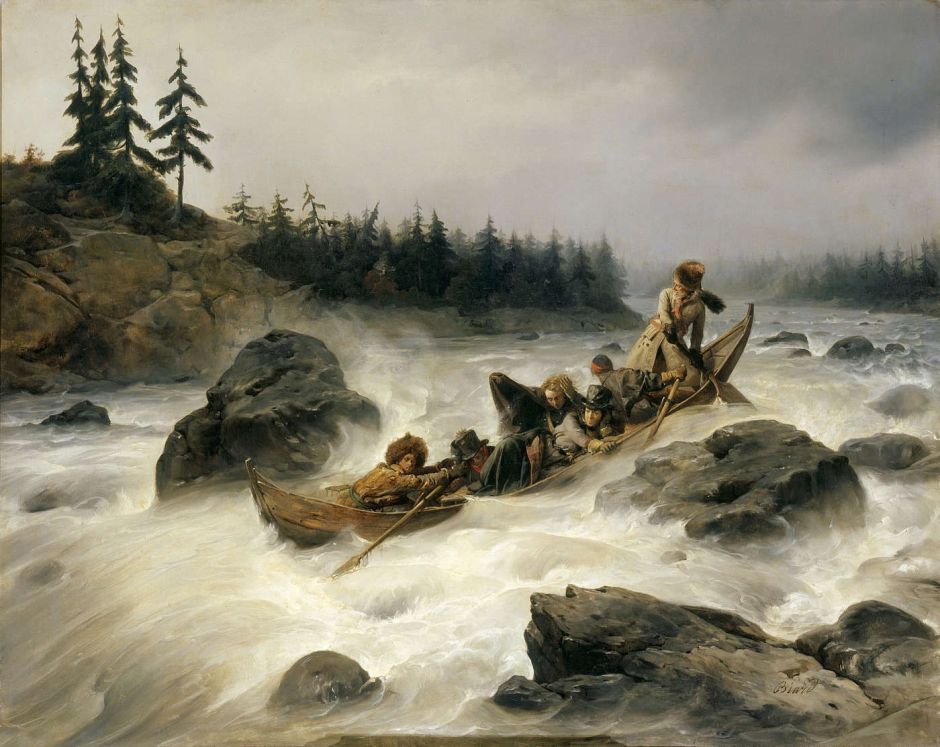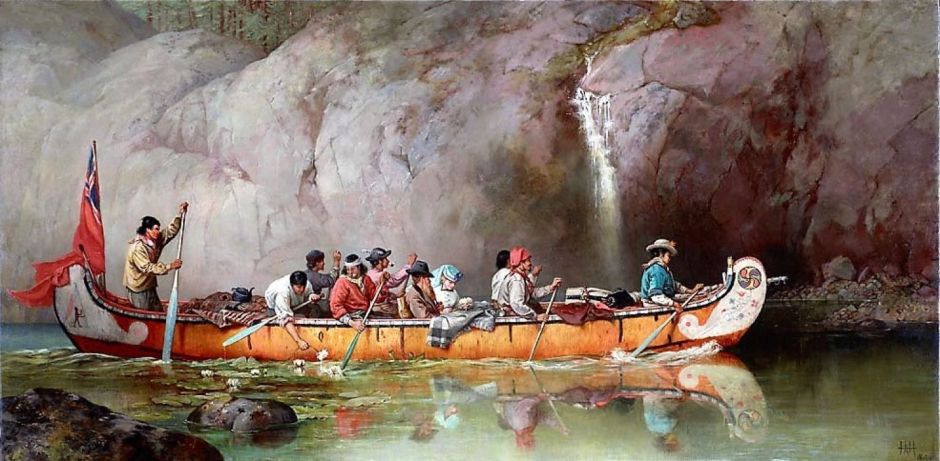Canoes, kayaks, dugouts and similar small craft have been used by almost every group of humans at some time, although as they weren’t a significant feature of Mediterranean cultures in classical times, they didn’t come to feature in European paintings until relatively recently. This weekend I show some of the better examples of paintings of these vessels from the nineteenth and twentieth centuries.
Those who attended the Salon of 1841 in Paris were treated to two paintings of canoes by the French artist-adventurer François-Auguste Biard.

The Duke of Orleans Riding Down the Great Rapid of Eijanpaikka at the Muonio River, Lapland, August 1795 (1840) shows the Duke enjoying a little white water canoeing in the far north of the Nordic countries. Biard’s depiction of the water is particularly interesting here, as this predates photography, which much later was able to use short exposures to effectively freeze motion.

View of the Arctic Ocean, Walrus Fishing by Greenlanders was also completed and exhibited in 1841. In a wild landscape of bizarre ice forms, a group of Inuit hunters in their kayaks are confronting huge walrus.
By the middle of the century, paintings made during expeditions in Australia were being returned to the public in Europe.

In 1868, Thomas Baines painted this view from his expedition in North Australia, showing Aboriginal Canoes Communicating with the ‘Monarch’ and the ‘Tom Tough’, 28 August 1855. This shows Augustus Gregory’s exploration of the Gulf of Carpentaria, south of Prince of Wales Island. The canoe is approaching the stern of the schooner Tom Tough, commanded by Captain Gourlay. Canoes are also approaching the barque Monarch in the left distance.
The finest paintings of canoes at this time were made by Frances Anne Hopkins, who married the secretary to the Governor-General of the Hudson’s Bay Company, which was responsible for much of the fur and other trade in central and northern Canada at the time. Following her marriage, the family moved to Lachine, in what was then Lower Canada, now part of the city of Montreal, where her husband worked.
Hopkins wasn’t content to be a housewife and hostess, and accompanied her husband on his business trips whenever possible. Between their arrival in 1858 and her husband’s retirement in 1870 she is known to have travelled with him on at least three major trips in 1864, 1866 and 1869, extending to Manitoulin Island, Lake Huron, and Kakabeka Falls, Lake Superior.
She became one of very few women to travel long distances by canoe, as a voyageur. She drew and sketched extensively during her trips, then developed those into more finished watercolours and oil paintings when she was in her studio at home. In 1869, during preparations for their departure from Canada, she exhibited many of her paintings in Montreal, becoming the first woman to do so.
Hopkins was even more successful when they had returned to Britain. She first exhibited at the Royal Academy in London in 1869, and enjoyed greater commercial success in the British market over the following two decades. She continued to work in her studio in Hampstead, on the outskirts of London, turning her Canadian voyageur sketches into finished oil paintings, and reproductions in print. Her last work to be exhibited at the Royal Academy was in 1902, and she died in 1919, at the age of eighty-one.

Canoe Manned by Voyageurs Passing a Waterfall (Canada) from 1869 shows a large freight canoe operated by the Hudson’s Bay Company passing a waterfall. This is presumed to be on the French River. One of the paddlers is picking water-lily flowers, which they are passing to Hopkins, who is sat next to her husband.

Canoes in a Fog, Lake Superior from 1869 is a substantial oil painting which was her first work exhibited at the Royal Academy that year. Once again the artist shows herself and her husband sitting in the canoe.

Encampment of Voyageurs from 1870 shows a couple of canoe parties camping on a small beach during a trip.

Shooting the Rapids (Quebec) from 1879 is another major oil painting of hers which was justly popular. The artist places herself in the middle of the canoe, with her husband on her left (I think).

